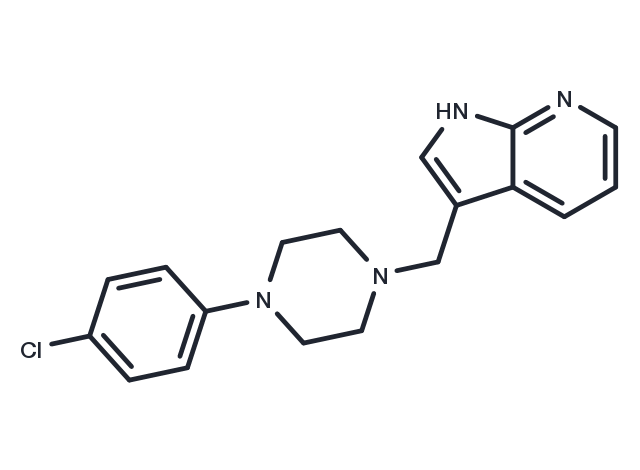Powder: -20°C for 3 years | In solvent: -80°C for 1 year


L-745870 is a high-affinity and selective human dopamine D4 receptor antagonist (Ki: 0.43 nM). L-745870 has excellent brain penetration. It considerably weaker D2 (Ki: 960 nM) and D3 (Ki: 2300 nM) receptors affinity.

| Pack Size | Availability | Price/USD | Quantity |
|---|---|---|---|
| 2 mg | 5 days | $ 35.00 |
| Description | L-745870 is a high-affinity and selective human dopamine D4 receptor antagonist (Ki: 0.43 nM). L-745870 has excellent brain penetration. It considerably weaker D2 (Ki: 960 nM) and D3 (Ki: 2300 nM) receptors affinity. |
| Targets&IC50 | D2 receptor (human):960 nM(ki), D4 receptor (human):(ki)0.43 nM, D3 receptor (human):2300 nM(ki) |
| In vitro | L-745870 is an antagonist at human D4 receptors which displayed in vitro pharmacological studies. In that L-745870 is capable of antagonizing the ability of D4 receptors to inhibit agonist-induced stimulation of [35S]-GTPgS binding. It blocking the inhibition of forskolin-stimulated adenylate cyclase activity in the transfected human embryonic kidney (HEK293) and Chinese hamster ovary (CHO) cells and also blocking dopamine-induced inhibition of Ca2+ currents in transfected GH4C1 pituitary cells. L-745870 inhibiting D4 activation of cloned G protein-coupled inwardly rectifying K+ channels and antagonizing dopamine-induced stimulation of extracellular acidification in transfected cells[1][2]. |
| In vivo | L-745870 has good pharmacokinetic properties (20-60% oral bioavailability and plasma t1/2 2.1-2.8 hours) in both rat and monkey, and excellent brain penetration with the high brain to plasma ratios in the rat. L-745870 has no effect on apomorphine-induced stereotypy in rats but does induce catalepsy in mice, albeit at a high dose of 100 mg/kg p.o. that is likely to occupy D2 receptors in vivo. Evaluation of L-745870 in surrogate marker assays shows that this compound is freely available for biological activity in the brain and L-745870(5 to 60 mg/kg; p.o.) treatment, would occupy 50% D4 receptors in the brain. Following oral administration to squirrel monkeys, L745870 (10 mg/kg p.o.) causes mild sedation and extrapyramidal motor symptoms, notably bradykinesia became apparent at 30 mg/kg. High doses of L-745870 might also be expected to induce extrapyramidal symptoms in primates because the levels in the CNS at these doses would be sufficient to antagonize D2 receptors. Lower doses of L-745870 has no observable behavioral effects in monkeys[1][2]. |
| Molecular Weight | 326.82 |
| Formula | C18H19ClN4 |
| CAS No. | 158985-00-3 |
Powder: -20°C for 3 years | In solvent: -80°C for 1 year
You can also refer to dose conversion for different animals. More
bottom
Please see Inhibitor Handling Instructions for more frequently ask questions. Topics include: how to prepare stock solutions, how to store products, and cautions on cell-based assays & animal experiments, etc.
L-745870 158985-00-3 GPCR/G Protein Neuroscience Dopamine Receptor L745870 L 745870 inhibitor inhibit
